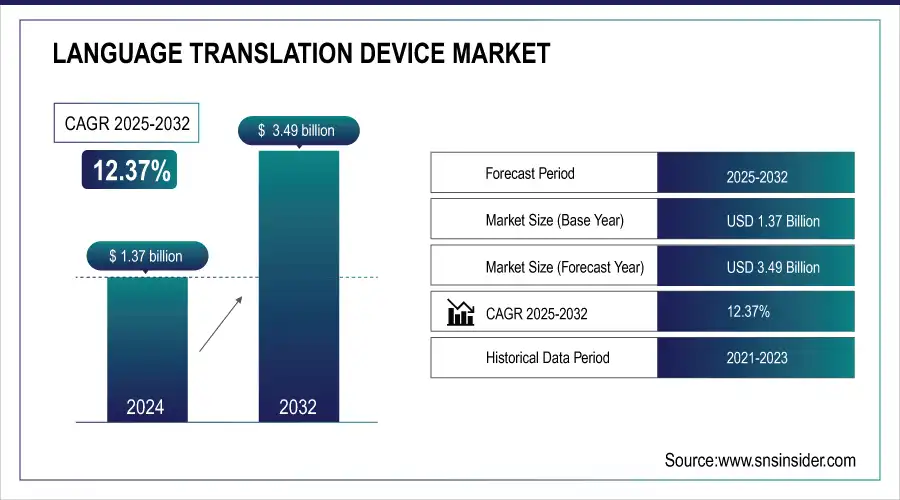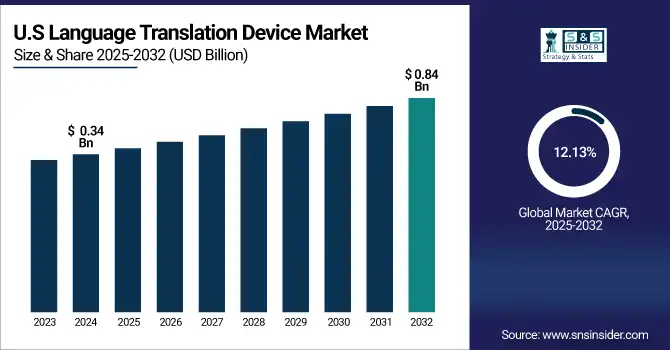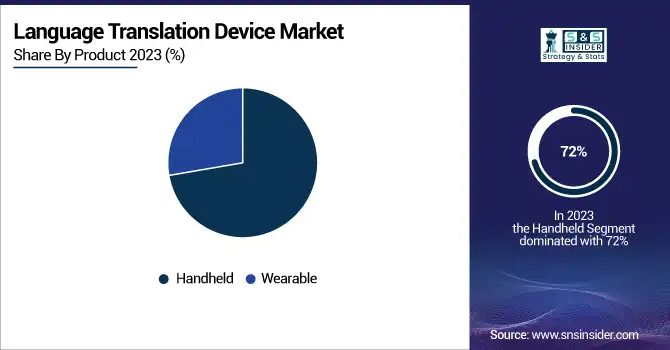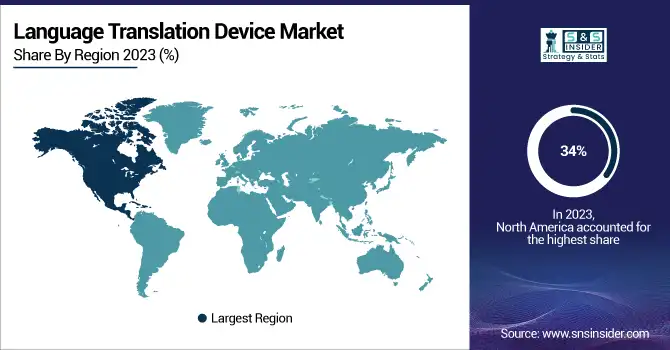Language Translation Device Market Report Scope & Overview:
The Language Translation Device Market was valued at USD 1.37 billion in 2024 and is expected to reach USD 3.49 billion by 2032, growing at a CAGR of 12.37% from 2025-2032.

To Get more information on Language Translation Device Market - Request Free Sample Report
This report includes detailed insights into language demand statistics, battery performance, voice recognition capabilities by accent, language accuracy metrics, and security and privacy concern statistics. The market is experiencing rapid growth due to increasing globalization, rising travel and tourism, and growing demand for real-time communication across language barriers. Advancements in AI and machine learning have significantly enhanced translation accuracy and voice recognition, even across diverse accents. Additionally, manufacturers are focusing on extending battery life and addressing user concerns about data privacy and security. These developments, coupled with expanding use cases in healthcare, business, education, and defense, are expected to drive sustained demand for language translation devices throughout the forecast period.
Language Translation Device Market Size and Forecast
-
Language Translation Device Market Size in 2024: USD 1.37 Billion
-
Language Translation Device Market Size by 2032: USD 3.49 Billion
-
CAGR: 12.37% from 2025 to 2032
-
Base Year: 2024
-
Forecast Period: 2025–2032
-
Historical Data: 2021–2023
Language Translation Device Market Trends
-
Rising globalization and cross-border communication needs are driving language translation device adoption.
-
Advancements in AI, NLP, and speech recognition are enhancing translation accuracy and real-time capabilities.
-
Growing use in travel, business, education, and healthcare sectors is boosting market growth.
-
Integration with mobile apps and cloud platforms is enabling seamless multilingual communication.
-
Increasing demand for portable, offline, and wearable translation devices is improving accessibility.
-
Expansion of tourism and international trade is fueling device adoption worldwide.
-
Collaborations between tech companies, language service providers, and AI startups are accelerating innovation.
U.S. Language Translation Device Market was valued at USD 0.34 billion in 2024 and is expected to reach USD 0.84 billion by 2032, growing at a CAGR of 12.13% from 2025-2032.
The market's growth is driven by the increasing cultural diversity and multilingual population in the U.S., along with the rising need for seamless communication in sectors such as healthcare, tourism, education, and government services. The growing adoption of AI-powered translation devices in both personal and professional settings, along with advancements in voice recognition and natural language processing, is further fueling demand. Additionally, increased international business interactions and a heightened focus on accessible communication are contributing to the steady rise in translation device usage across the country.

Language Translation Device Market Growth Drivers:
-
Increasing globalization and cross-border interactions are fueling demand for real-time language translation solutions across diverse industries worldwide.
The growth in globalization, global business operations, and cross-cultural tourism has greatly increased the need for real-time language translation devices. Businesses going global require smooth communication tools to communicate with clients and partners of diverse linguistic backgrounds. Furthermore, extensive international travel and global tourism require effective communication aids, particularly in areas with language barriers. Healthcare, legal, and education industries also increasingly depend on language translation devices to provide clear understanding and avoid miscommunication. These devices reduce the need for human translators, providing portability, convenience, and quick processing. Increased multilingual customer support and international supply chains further require effective language translation. Thus, this growing global connectivity propels the use of new language translation solutions to facilitate smooth and accurate cross-language communication.
Language Translation Device Market Restraints:
-
Limited language database and poor contextual accuracy can reduce reliability and performance of translation devices in complex scenarios.
Even with advancements in technology, most language translation gadgets continue to lack context sensitivity, colloquial usage, and slangs, which reduces their overall accuracy. The majority of the gadgets are tuned with common languages, and many regional and minority languages are not supported. This limits utilization in multilingual societies where correct translation is essential. Literal translation or misinterpretation is common in complex communication, like legal or medical communication, resulting in miscommunication. Additionally, voice recognition in real time may fail in noisy situations or where there are heavy accents, lowering the confidence of users. These constraints limit the performance of such devices in business or serious situations. Until there are major advances in language databases and contextual learning, dependence on human translators is still more desirable in some industries, holding back more widespread use of translation devices.
Language Translation Device Market Opportunities:
-
Product innovation and strategic collaborations offer opportunities to improve device capabilities and enter new application areas.
Ongoing advances in hardware design, speech recognition, and AI algorithms offer significant opportunities to advance language translation devices. Technologies such as wearables, earbuds, and app-enabled tools are redefining user experience and broadening product lines. More customized solutions can be created through strategic partnerships with technology heavyweights, schools, and travel agencies. Dealing with local language experts also enables the incorporation of niche languages and cultural differences, broadening market outreach. Incorporating translation devices in industries like e-commerce, customer support, and telemedicine also presents new verticals for expansion. With remote work and global collaboration on the rise, the need for effective real-time translation across digital platforms is on the rise. These developments provide manufacturers with plenty of opportunities to diversify and expand their global reach through focused product development.
Language Translation Device Market Challenges:
-
Maintaining translation accuracy and context across diverse languages remains a significant technical and user trust challenge.
Maintaining high accuracy of translation from hundreds of the world's languages, dialects, and speaking varieties is a significant challenge for device makers. Most languages possess intricate grammatical rules, meaning dependent on context, and cultural allusions that are difficult to translate well with AI. Users tend to complain about errors or word-for-word translation, especially in live conversation or technical topics, decreasing trust in the device. Language evolves, and frequent revisions are essential to accommodate changing usage. For sensitive areas such as healthcare or law, minor errors can be disastrous. Construction of tone-sensing, intent-sensing, and emotion-sensing devices is technically challenging, and without realizing this, a large number of users are hesitant to trust entirely in machines for critical communication functions, impacting the mass adoption of translation technology.
Language Translation Device Market Segment Analysis
By Product, Handheld translation devices dominate the market. Wearable translation devices are expected to grow fastest.
Handheld translation devices accounted for the largest revenue share of around 72% in 2024 due to their high portability, user-friendly interface, and affordability. These devices are especially popular among travelers, business professionals, and educators who require real-time translation without complex setup or internet connectivity. Their offline functionality, long battery life, and wide language support make them convenient for on-the-go use. The established reliability and wide availability of handheld devices have helped them gain strong market preference over other types.
Wearable translation devices are projected to grow at the fastest CAGR of approximately 13.90% from 2025 to 2032 due to rising demand for seamless, hands-free communication solutions. With growing interest in smart wearables and advancements in miniaturized technology, these devices are becoming more stylish and comfortable. Integration with earbuds, glasses, and smartwatches makes them ideal for travelers, customer service agents, and multilingual meetings. Enhanced connectivity and real-time translation make wearables increasingly attractive to tech-savvy users seeking unobtrusive solutions.

By Application, Commercial applications dominate the market. Consumer applications are expected to grow fastest.
The commercial segment dominated the Language Translation Device Market in 2024 with a revenue share of 62%, driven by rising demand in sectors like tourism, hospitality, business, education, and healthcare. Enterprises use these devices to overcome language barriers during meetings, conferences, and international collaborations. Hotels, airports, and multinational corporations implement translation tools to improve customer experience and communication with global clients. The growing emphasis on global expansion and culturally diverse workforces has made commercial applications a primary revenue source for translation device manufacturers.
The consumer segment is expected to grow at the fastest CAGR of about 13.60% from 2025 to 2032 due to increasing international travel, migration, and interest in cross-cultural communication. As technology becomes more accessible, individuals are adopting translation devices for personal use in travel, education, and social interaction. The rise of solo travel, digital nomadism, and language learning trends further supports growth. Consumer preference for portable, easy-to-use solutions fuels demand, especially among younger, tech-friendly demographics seeking real-time multilingual assistance.
By Type, Online translation dominates the market.
The online translation segment held the largest market share of approximately 63% in 2024, primarily due to its convenience, speed, and extensive language coverage. Users benefit from immediate, cloud-based translation services that are accessible across multiple platforms and devices. Businesses and individuals prefer online solutions for real-time interactions, especially in virtual meetings, emails, and customer service. The scalability and cost-efficiency of online translation tools make them ideal for large enterprises, educational institutions, and travelers alike. Additionally, integration with AI and machine learning has significantly improved translation accuracy, context recognition, and user experience, further enhancing their appeal. With increasing internet penetration and reliance on digital communication, online translation continues to dominate the market by offering flexibility, real-time updates, and cross-platform compatibility that traditional offline or device-only models cannot easily match.
By Distribution Channel, Online platforms are expected to grow fastest.
Online platforms are projected to grow at the fastest CAGR of about 13.11% from 2025 to 2032, driven by the increasing shift toward digital interaction and remote communication. As more people engage in virtual meetings, e-learning, online shopping, and international social networking, the need for instant translation via online platforms becomes essential. Cloud-based solutions offer continuous improvements, frequent language updates, and contextual learning through AI algorithms, making them more effective over time. These platforms are accessible via smartphones, tablets, and desktops, making them versatile for both casual users and professionals. Moreover, the proliferation of subscription-based and freemium translation services appeals to a wide range of users looking for budget-friendly yet powerful language tools. The rise of multilingual online content also contributes significantly to this rapid growth.
Language Translation Device Market Regional Analysis
North America Language Translation Device Market Insights
North America dominated the Language Translation Device Market in 2024 with a revenue share of approximately 34%, owing to advanced technological infrastructure, high adoption of AI-driven solutions, and strong presence of leading market players. The region's diverse multicultural population, robust tourism, and global business operations contribute to high demand for effective translation tools. Additionally, government initiatives and investments in language access services, along with widespread smartphone usage and internet connectivity, support the growth and dominance of this market in the region.

Get Customized Report as per Your Business Requirement - Enquiry Now
Asia Pacific Language Translation Device Market Insights
Asia Pacific is expected to grow at the fastest CAGR of around 14.01% from 2025 to 2032 due to increasing cross-border trade, rising tourism, and growing multicultural populations. Emerging economies like China, India, and Southeast Asian countries are experiencing rapid digitalization and international business expansion. With a large number of regional languages and dialects, the demand for translation solutions is high. Increasing smartphone adoption, internet access, and tech-savvy consumers also drive accelerated growth across this region.
Europe Language Translation Device Market Insights
Europe holds a significant position in the Language Translation Device Market, driven by increasing globalization, cross-border trade, and tourism. Growing adoption of AI-powered translation solutions in business, education, and travel sectors, along with strong technological infrastructure, supports market growth. Countries like Germany, the UK, and France are leading in innovation, while collaborations between tech companies and local distributors further enhance accessibility and adoption of advanced language translation devices across the region.
Middle East & Africa and Latin America Language Translation Device Market Insights
The Middle East & Africa and Latin America are emerging markets for the Language Translation Device Market, fueled by rising international trade, tourism, and multicultural communication needs. Increasing adoption of AI-driven translation devices in education, business, and travel, along with growing smartphone penetration and e-commerce expansion, is driving growth. Countries such as Brazil, Mexico, UAE, and Saudi Arabia are witnessing heightened demand, highlighting strong market potential in these regions.
Language Translation Device Market Competitive Landscape:
Google LLC
Google is a global technology leader specializing in internet services, cloud computing, AI, and machine learning. Its AI-driven tools, including Google Translate, leverage advanced neural networks to provide real-time language translation, support global communication, and enhance accessibility for users worldwide. Google continuously invests in AI and natural language processing to expand its product offerings and strengthen its position in the global AI and language services market.
-
In June 2024, Google Translate expanded its capabilities by adding 110 new languages, including Awadhi, Marwadi, and Punjabi (Shahmukhi). This expansion, powered by Google's PaLM 2 AI model, aims to enhance communication for over 614 million speakers globally.
iFLYTEK Co., Ltd.
iFLYTEK is a Chinese AI company focusing on speech recognition, natural language processing, and intelligent voice interaction technologies. It develops AI-powered devices and software solutions for real-time translation, education, and business applications. With a global expansion strategy, iFLYTEK aims to provide multilingual communication solutions, enhance user experience, and strengthen its footprint in emerging markets through innovative AI-driven translation technologies.
-
In March 2024, iFLYTEK launched its Smart Translator in Dubai, marking the company's entry into the Middle Eastern market. The device features multi-language automatic recognition and is available in local retail channels like Dubai Mall.
Vasco Electronics
Vasco Electronics is a global electronics company specializing in AI-powered translation devices, language learning tools, and communication technologies. Its products enable real-time speech translation across multiple languages, catering to travelers, businesses, and educational institutions. The company emphasizes innovation, portability, and user-friendly interfaces to enhance global communication and bridge language barriers, supporting seamless interaction in personal and professional settings.
-
In January 2025, Vasco Electronics unveiled the Vasco Translator E1 at CES 2025. These AI-powered earbuds support over 50 languages, enabling real-time, multi-user communication. Priced at $389, they offer both touchless and manual translation modes.
Key Players
Some of the Language Translation Device Market Companies
-
Jarvisen (Jarvisen Translator 2, Jarvisen Translator Pro)
-
Langogo Inc (Langogo Genesis, Langogo Summit)
-
Mymanu CEH Tech LTD (Mymanu CLIK S, Mymanu Translate App)
-
Sourcenext Inc. (Pocketalk) (Pocketalk Classic, Pocketalk S)
-
Timekettle (Timekettle WT2 Edge, Timekettle M3)
-
Travis GT B.V. (Travis Touch Plus, Travis One)
-
Vasco Electronics LLC (Vasco Translator V4, Vasco Translator E1)
-
VORMOR (VORMOR T9, VORMOR X5)
-
Cheetah Mobile, Inc. (CM Translator, CM Smart Pen)
-
Waverly Labs Inc. (Ambassador Interpreter, Forum App)
-
IBM (IBM Watson Language Translator, IBM Watson Assistant)
-
iFlytek (iFLYTEK Smart Translator, iFLYTEK Smart Recorder)
-
Pocketalk (Pocketalk Classic, Pocketalk S)
-
Google (Google Translate, Pixel Buds)
-
Sogou (Sogou Travel Translator, Sogou Voice Translator)
-
Apple (Apple Translate App, Siri Translation)
-
Translatelive (Translatelive App, Translatelive Kiosk)
-
Jovee (Jovee Translator, Jovee Voice Translator)
-
Microsoft (Microsoft Translator, Skype Translator)
-
Sonix (Sonix Transcription Software, Sonix Translation Tool)
-
Amazon (Alexa Translation, Amazon Translate)
| Report Attributes | Details |
|---|---|
| Market Size in 2024 | US$ 1.37 Billion |
| Market Size by 2032 | US$ 3.49 Billion |
| CAGR | CAGR of 12.37% From 2025 to 2032 |
| Base Year | 2024 |
| Forecast Period | 2025-2032 |
| Historical Data | 2021-2023 |
| Report Scope & Coverage | Market Size, Segments Analysis, Competitive Landscape, Regional Analysis, DROC & SWOT Analysis, Forecast Outlook |
| Key Segments | • By Product (Handheld, Wearable) • By Type (Online Translation, Offline Translation) • By Application (Consumer, Commercial) • By Distribution Channel (Online Platforms, Retail Stores) |
| Regional Analysis/Coverage | North America (US, Canada, Mexico), Europe (Eastern Europe [Poland, Romania, Hungary, Turkey, Rest of Eastern Europe] Western Europe] Germany, France, UK, Italy, Spain, Netherlands, Switzerland, Austria, Rest of Western Europe]), Asia Pacific (China, India, Japan, South Korea, Vietnam, Singapore, Australia, Rest of Asia Pacific), Middle East & Africa (Middle East [UAE, Egypt, Saudi Arabia, Qatar, Rest of Middle East], Africa [Nigeria, South Africa, Rest of Africa], Latin America (Brazil, Argentina, Colombia, Rest of Latin America) |
| Company Profiles | Jarvisen, Langogo Inc, Mymanu CEH Tech LTD, Sourcenext Inc. (Pocketalk), Timekettle, Travis GT B.V., Vasco Electronics LLC, VORMOR, Cheetah Mobile, Inc., Waverly Labs Inc., IBM, iFlytek, Pocketalk, Google, Sogou, Apple, Translatelive, Jovee, Microsoft, Sonix, Amazon |

